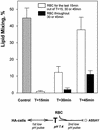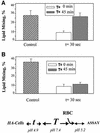Reversible stages of the low-pH-triggered conformational change in influenza virus hemagglutinin
- PMID: 12411488
- PMCID: PMC131056
- DOI: 10.1093/emboj/cdf559
Reversible stages of the low-pH-triggered conformational change in influenza virus hemagglutinin
Abstract
The refolding of the prototypic fusogenic protein hemagglutinin (HA) at the pH of fusion is considered to be a concerted and irreversible discharge of a loaded spring, with no distinct intermediates between the initial and final conformations. Here, we show that HA refolding involves reversible conformations with a lifetime of minutes. After reneutralization, low pH-activated HA returns from the conformations wherein both the fusion peptide and the kinked loop of the HA2 subunit are exposed, but the HA1 subunits have not yet dissociated, to a structure indistinguishable from the initial one in functional, biochemical and immunological characteristics. The rate of the transition from reversible conformations to irreversible refolding depends on the pH and on the presence of target membrane. Importantly, recovery of the initial conformation is blocked by the interactions between adjacent HA trimers. The existence of the identified reversible stage of refolding can be crucial for allowing multiple copies of HA to synchronize their release of conformational energy, as required for fusion.
Figures







Similar articles
-
The final conformation of the complete ectodomain of the HA2 subunit of influenza hemagglutinin can by itself drive low pH-dependent fusion.J Biol Chem. 2011 Apr 15;286(15):13226-34. doi: 10.1074/jbc.M110.181297. Epub 2011 Feb 3. J Biol Chem. 2011. PMID: 21292763 Free PMC article.
-
pH-induced conformational changes of membrane-bound influenza hemagglutinin and its effect on target lipid bilayers.Protein Sci. 1998 Nov;7(11):2359-73. doi: 10.1002/pro.5560071113. Protein Sci. 1998. PMID: 9828002 Free PMC article.
-
Synchronized activation and refolding of influenza hemagglutinin in multimeric fusion machines.J Cell Biol. 2001 Nov 26;155(5):833-44. doi: 10.1083/jcb.200103005. Epub 2001 Nov 26. J Cell Biol. 2001. PMID: 11724823 Free PMC article.
-
Early steps of the conformational change of influenza virus hemagglutinin to a fusion active state: stability and energetics of the hemagglutinin.Biochim Biophys Acta. 2003 Jul 11;1614(1):3-13. doi: 10.1016/s0005-2736(03)00158-5. Biochim Biophys Acta. 2003. PMID: 12873761 Review.
-
Architecture of the influenza hemagglutinin membrane fusion site.Biochim Biophys Acta. 2003 Jul 11;1614(1):24-35. doi: 10.1016/s0005-2736(03)00160-3. Biochim Biophys Acta. 2003. PMID: 12873763 Review.
Cited by
-
Conformational change of influenza virus hemagglutinin is sensitive to ionic concentration.Eur Biophys J. 2007 Apr;36(4-5):327-35. doi: 10.1007/s00249-006-0116-0. Epub 2007 Jan 9. Eur Biophys J. 2007. PMID: 17211621
-
Identification of a pH sensor in Influenza hemagglutinin using X-ray crystallography.J Struct Biol. 2020 Jan 1;209(1):107412. doi: 10.1016/j.jsb.2019.107412. Epub 2019 Nov 2. J Struct Biol. 2020. PMID: 31689502 Free PMC article.
-
Targeting receptor-mediated endocytotic pathways with nanoparticles: rationale and advances.Adv Drug Deliv Rev. 2013 Jan;65(1):121-38. doi: 10.1016/j.addr.2012.09.041. Epub 2012 Sep 29. Adv Drug Deliv Rev. 2013. PMID: 23026636 Free PMC article. Review.
-
Inactivation mechanisms of influenza A virus under pH conditions encountered in aerosol particles as revealed by whole-virus HDX-MS.mSphere. 2023 Oct 24;8(5):e0022623. doi: 10.1128/msphere.00226-23. Epub 2023 Aug 18. mSphere. 2023. PMID: 37594288 Free PMC article.
-
pH regulation in early endosomes and interferon-inducible transmembrane proteins control avian retrovirus fusion.J Biol Chem. 2017 May 12;292(19):7817-7827. doi: 10.1074/jbc.M117.783878. Epub 2017 Mar 24. J Biol Chem. 2017. PMID: 28341742 Free PMC article.
References
-
- Bullough P.A., Hughson,F.M., Skehel,J.J. and Wiley,D.C. (1994) Structure of influenza haemagglutinin at the pH of membrane fusion. Nature, 371, 37–43. - PubMed
-
- Carr C.M. and Kim,P.S. (1993) A spring-loaded mechanism for the conformational change of influenza hemagglutinin. Cell, 73, 823–832. - PubMed
-
- Chen J., Lee,K.H., Steinhauer,D.A., Stevens,D.J., Skehel,J.J. and Wiley,D.C. (1998) Structure of the hemagglutinin precursor cleavage site, a determinant of influenza pathogenicity and the origin of the labile conformation. Cell, 95, 409–417. - PubMed
MeSH terms
Substances
LinkOut - more resources
Full Text Sources
Other Literature Sources
Research Materials
Miscellaneous

